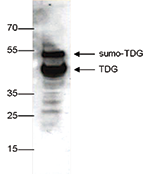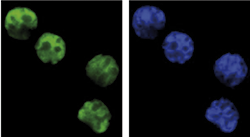TDG (UniProt/Swiss-Prot entry Q13569) belongs to the TDG/mug DNA glycosylase family. It removes thymine moieties from G/T mismatches by hydrolyzing the carbon-nitrogen bond between the sugar-phosphate backbone of DNA and the mispaired thymine. It is also able to remove thymine from C/T and T/T mispairings, although with lower activity. Furrther, TDG plays a key role in active DNA demethylation as it binds to 5-formylcytosine (5fC) and 5-carboxylcytosine (5caC), but not 5-hydroxymethylcytosine (5hmC), and mediates their excision through base-excision repair (BER) to install an unmethylated cytosine.




